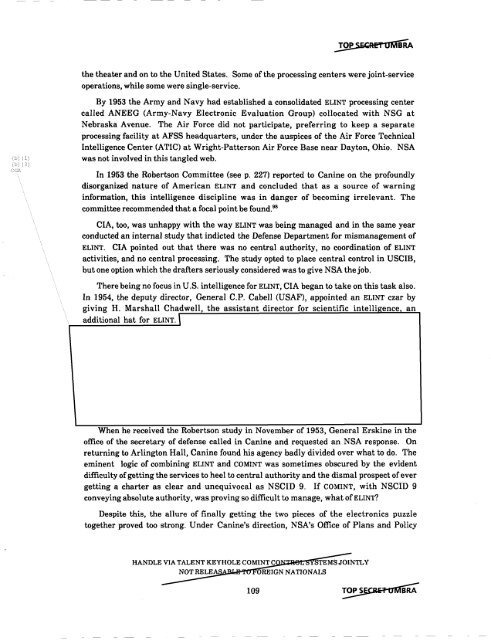American Cryptology during the Cold War - The Black Vault
American Cryptology during the Cold War - The Black Vault
American Cryptology during the Cold War - The Black Vault
Create successful ePaper yourself
Turn your PDF publications into a flip-book with our unique Google optimized e-Paper software.
<strong>the</strong> <strong>the</strong>ater and on to <strong>the</strong> United States. Some of <strong>the</strong> processing centers were joint-service<br />
operations, while some were single-service.<br />
Ib) (1)<br />
Ib) (3)<br />
OGA<br />
By 1953 <strong>the</strong> Army and Navy had established a consolidated ELINT processing center<br />
called ANEEG (Army-Navy Electronic Evaluation Group) collocated with NSG at<br />
Nebraska Avenue. <strong>The</strong> Air Force did not participate, preferring to keep a separate<br />
processing facility at AFSS headquarters, under <strong>the</strong> auspices of <strong>the</strong> Air Force Technical<br />
Intelligence Center (ATIC) at Wright-Patterson Air Force Base near Dayton, Ohio. NSA<br />
was not involved in this tangled web.<br />
In 1953 <strong>the</strong> Robertson Committee (see p. 227) reported to Canine on <strong>the</strong> profoundly<br />
disorganized nature of <strong>American</strong> ELINT and concluded that as a source of warning<br />
information, this intelligence discipline was in danger of becoming irrelevant. <strong>The</strong><br />
committee recommended that a focal point be found. 98<br />
CIA, too, was unhappy with <strong>the</strong> way ELINT was being managed and in <strong>the</strong> same year<br />
conducted an internal study that indicted <strong>the</strong> Defense Department for mismanagement of<br />
ELINT. CIA pointed out that <strong>the</strong>re was no central authority, no coordination of ELINT<br />
activities, and no central processing. <strong>The</strong> study opted to place central control in USCIB,<br />
but one option which <strong>the</strong> drafters seriously considered was to give NSA <strong>the</strong> job.<br />
<strong>The</strong>re being no focus in U.S. intelligence for ELINT, CIA began to take on this task also.<br />
In 1954, <strong>the</strong> deputy director, General C.P. Cabell (USAF), appointed an ELINT czar by<br />
giving H. Marshall Chadwell, <strong>the</strong> assistant director for scientific intelli~ence an<br />
additional hat for ELINT. \<br />
When he received <strong>the</strong> Robertson study in November of 1953, General Erskine in <strong>the</strong><br />
office of <strong>the</strong> secretary of defense called in Canine and requested an NSA response. On<br />
returning to Arlington Hall, Canine found his agency badly divided over what to do. <strong>The</strong><br />
eminent logic of combining ELINT and COMINT was sometimes obscured by <strong>the</strong> evident<br />
difficulty of getting <strong>the</strong> services to heel to central authority and <strong>the</strong> dismal prospect ofever<br />
getting a charter as clear and unequivocal as NSCID 9. If COMINT, with NSCID 9<br />
conveying absolute authority, was proving so difficult to manage, what ofELINT?<br />
Despite this, <strong>the</strong> allure of finally getting <strong>the</strong> two pieces of <strong>the</strong> electronics puzzle<br />
toge<strong>the</strong>r proved too strong. Under Canine's direction, NSA's Office of Plans and Policy<br />
HANDLE VIA TALENT KEYHOLE COMINT C<br />
STEMS JOINTLY<br />
NOT RELEA<br />
OREIGN NATIONALS<br />
109
















